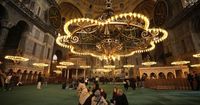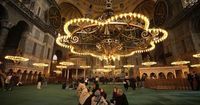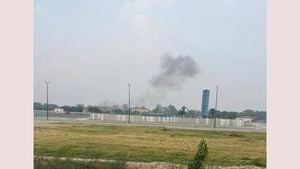ISTANBUL — Turkey has embarked on a significant new phase in the sweeping restorations of the nearly 1,500-year-old Hagia Sophia, focusing on preserving the monument's historic domes from the looming threat of earthquakes. This project, which aims to reinforce the main dome and half domes, will involve replacing worn lead coverings and upgrading the steel framework while allowing worship to continue uninterrupted in the mosque.
A newly installed tower crane on the eastern facade is expected to facilitate these efforts by transporting materials and expediting the renovations. "We have been carrying out intensive restoration efforts on Hagia Sophia and its surrounding structures for three years," said Dr. Mehmet Selim Okten, a construction engineer and lecturer at Mimar Sinan Fine Arts University, who is part of the scientific council overseeing the renovations. "At the end of these three years, we have focused on the seismic safety of Hagia Sophia, the minarets, the main dome, and the main arches, especially due to the expected Istanbul earthquake."
In 2023, a devastating magnitude 7.8 earthquake struck southern Turkey, wreaking havoc across the region and resulting in the deaths of over 53,000 people. Although Istanbul was spared from this catastrophe, the destruction to the south has heightened fears of a similar disaster affecting the city, which lies near major fault lines. Okten described the upcoming work as the most significant intervention in over 150 years and one of the most crucial in the structure's long history.
"A tower crane will be installed on the eastern facade, and then we will cover the top of this unique structure with a protective frame system," he explained. "That way, we can work more safely and examine the building's layers academically, including damage it suffered from fires and earthquakes in the 10th and 14th centuries."
Hagia Sophia was originally built as a church by the Byzantine Emperor Justinian in 537. Following the Ottoman conquest of Istanbul in 1453, it was converted into a mosque. Mustafa Kemal Ataturk, the founding leader of the Turkish republic, transformed it into a museum in 1934. However, in 2020, Turkey's highest administrative court overturned the 1934 decree, allowing it to reopen as a mosque once again.
Dr. Okten noted that while they have completed work on the four minarets and the main structure, the domes require special attention. "For this unique cultural heritage, we plan to use modern, lightweight materials and keep the building open to the public," he stated. Visitors to the site have expressed approval of the renovation plans. Rupert Wegerif, a lecturer at Cambridge University, remarked, "Hagia Sophia is amazing; it's one of the world's most important monuments. It seems really important that they are going to strengthen it in case of earthquakes and preserve it."
Okten emphasized that the renovation process would remain transparent to the public. "Although it’s not clear when we’ll finish, the public will be able to monitor our progress," he assured. "We have completed our work on the four minarets and the main structure. Now, for this unique cultural heritage—the domes—we are using modern, lightweight materials to maintain accessibility for the public."
As the restoration continues, a steel platform supported by four main columns, each standing 43.5 meters high, will be installed to facilitate the work while allowing worship to take place simultaneously. This innovative approach ensures that both the preservation of the historic site and the needs of the faithful are met.
Hagia Sophia continues to be a monument of global significance. Originally serving as a church for 916 years, it was a mosque for 482 years following its conversion by Sultan Mehmed II. In 1935, it opened as a museum, but its status changed again in 2020 when it was converted back into a mosque under President Recep Tayyip Erdogan's decision. Despite its active role as a mosque, Hagia Sophia remains a treasured cultural and architectural landmark, drawing millions of visitors each year.
As the restoration progresses, Turkey aims to ensure that Hagia Sophia stands resilient against future earthquakes, safeguarding its historical and cultural legacy for generations to come. The ongoing efforts reflect a commitment to preserving this iconic structure while adapting it to modern safety standards.
In summary, the restoration of Hagia Sophia is not only about reinforcing its physical structure but also about honoring a rich history that spans nearly 1,500 years. The careful balance between worship and preservation highlights the importance of this monument in both religious and cultural contexts, making it a focal point of heritage in Turkey and beyond.








